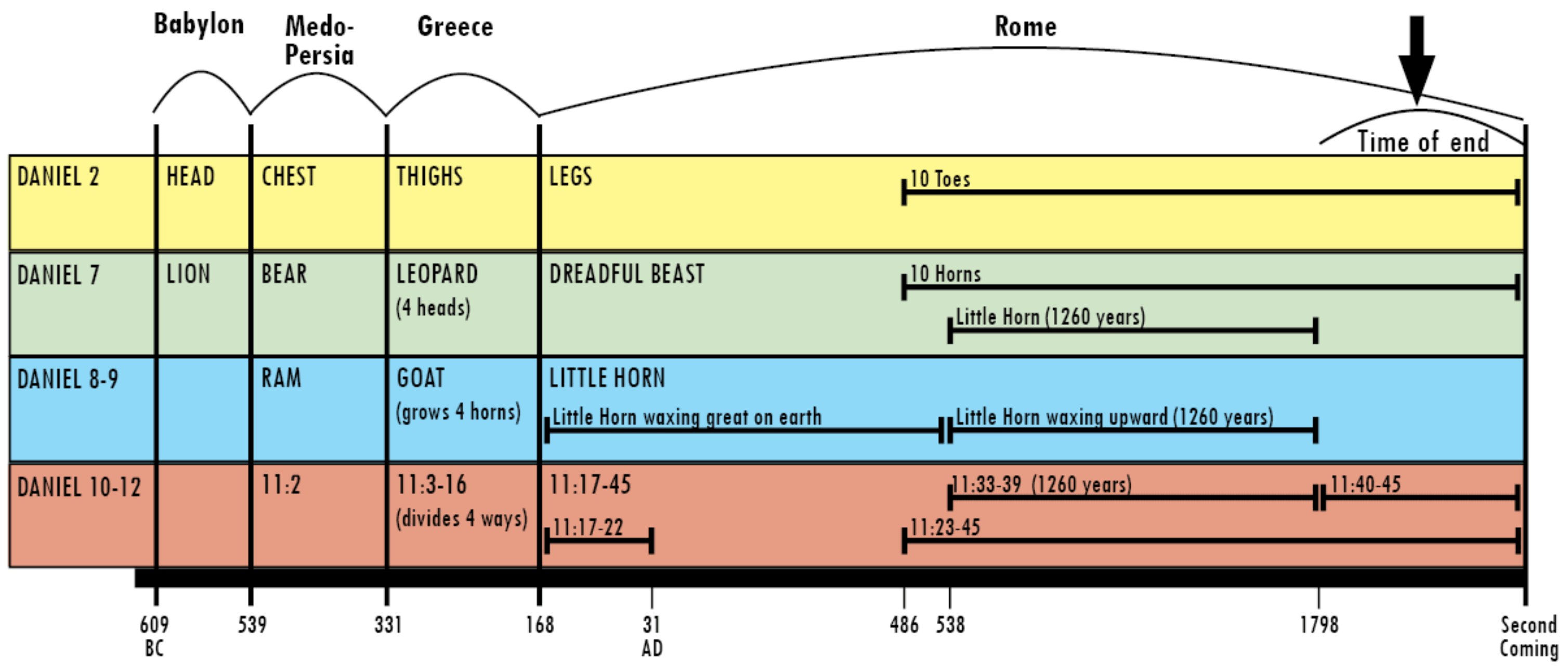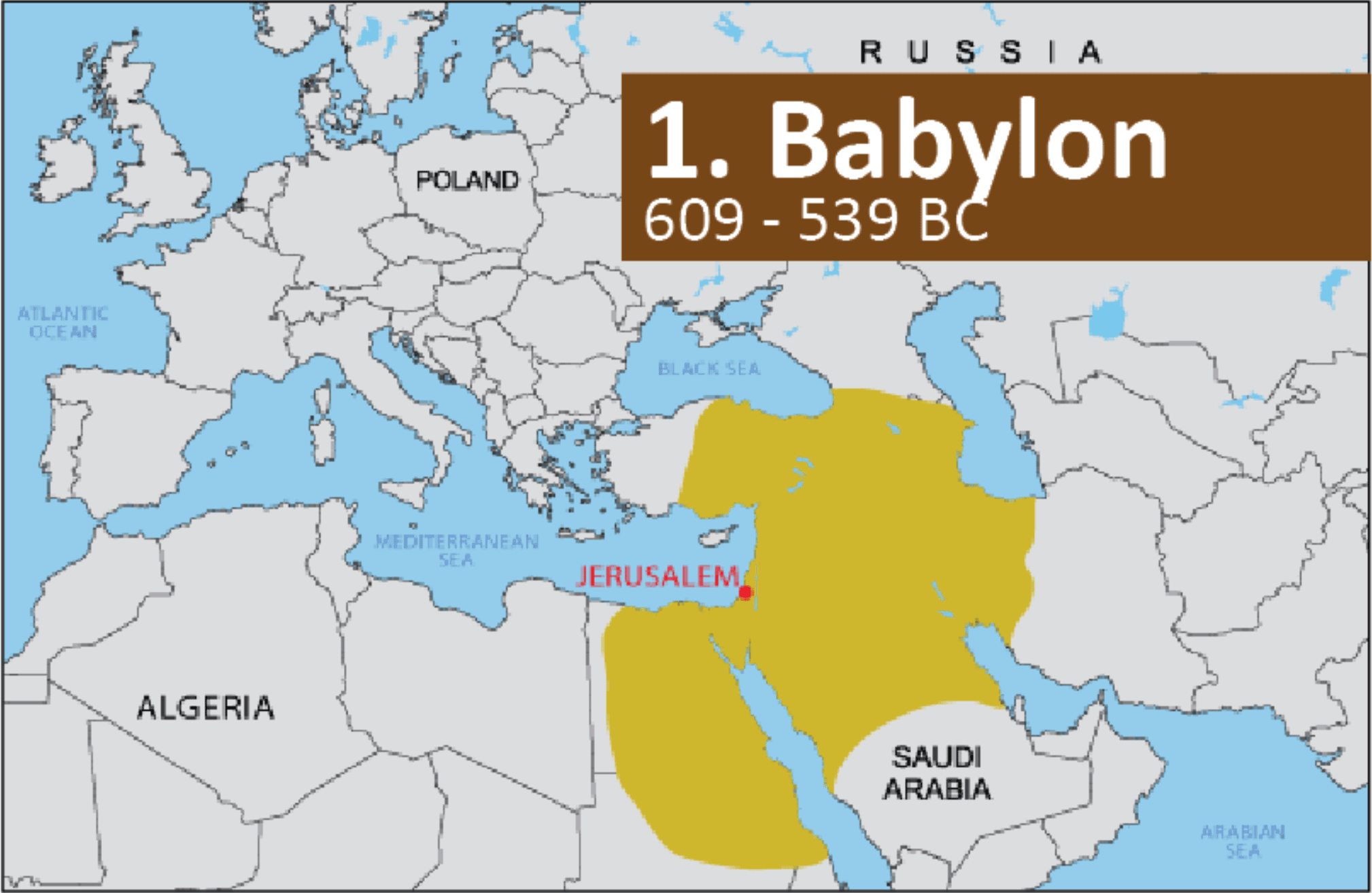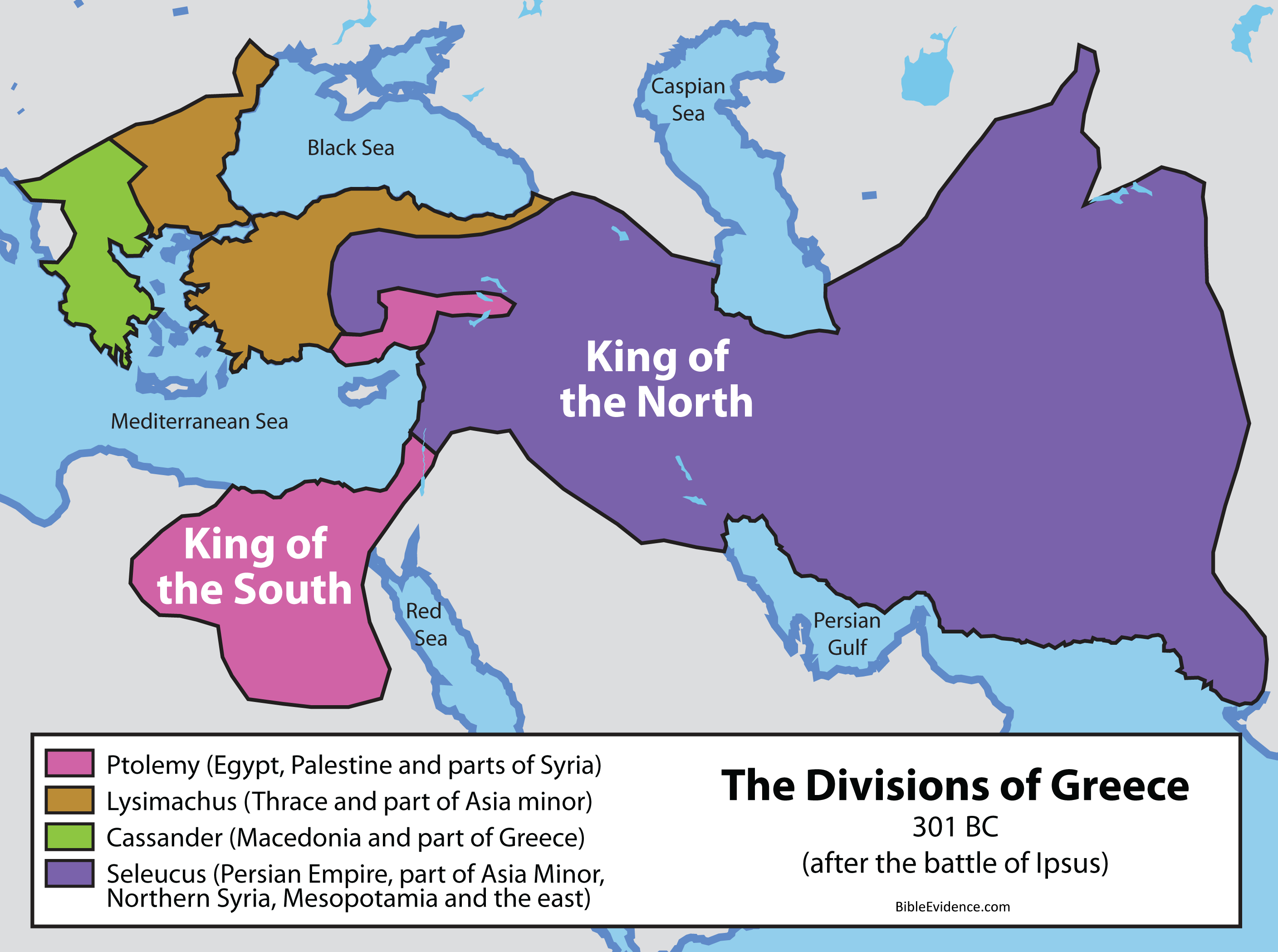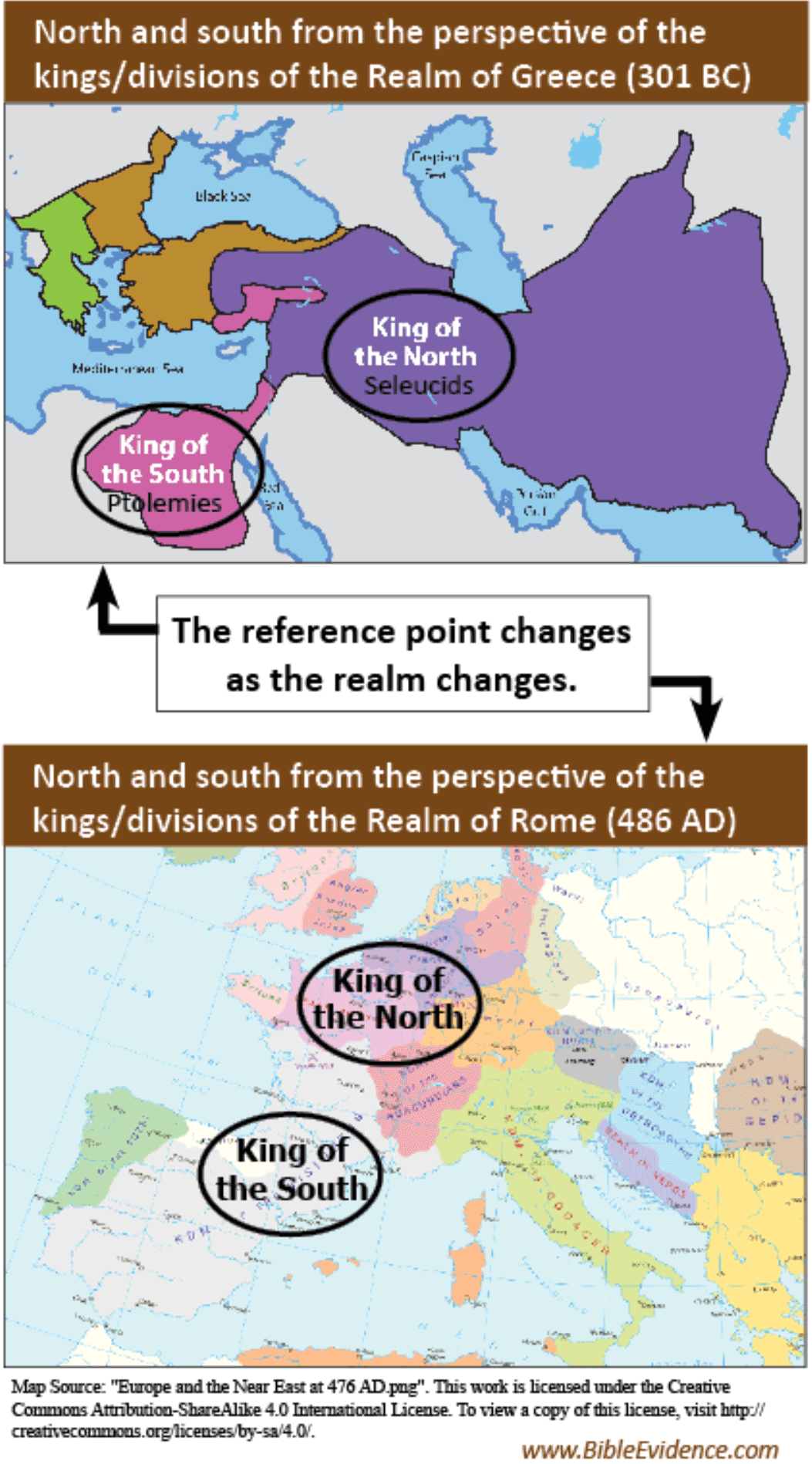
Precedents
The precedents established by Daniel in previous verses can be applied to the various sections of Daniel 11 to lead us to the interpretation. By following precedents we let Daniel interpret his own writings, and we let the Bible interpret itself.-
Precedent #1 - Daniel's prophecies follow an established succession of realms and events.
Daniel's prophecies in chapter 2, 7 and 8, parallel each other. They each reiterate the same succession of realms (Babylon, Medo-Persia, Greece, Rome, Jesus' Realm), and each adds more detail (Rome divides into 10, truth is trodden by a political-religious power, sanctuary is cleansed, Jesus returns). As Daniel 11 progresses through the events of Medo-Persia (Dan. 11:2), Greece (11:3-16), and Rome (11:17-45), a clear parallel is seen with Daniel's previous prophecies. When we get to the latter half of chapter 11, we can expect the clear parallels to continue. Events will either fit within that parallel framework to provide more detail and/or repeat the same events. This internal method of "repeat and enlarge" in the book of Daniel sets a precedent and tells us that the activities and identity of the KON and KOS (in the latter half of Daniel 11) can only be understood within the framework of divided Rome.

-
Precedent #2 - The context of Daniel's prophecies relocate as the territory of each realm shifts.
You may have wondered why the prophecies of Daniel and Revelation only mention certain kingdoms or realms. Many significant and powerful empires are not mentioned in Bible prophecy. In the prophecy of Daniel 2, there are four realms (Babylon, Medo-Persia, Greece, Rome) that would successively reign from Daniel's day until the Second Coming of Jesus. These realms are focused on because they are the realms that would rule over God's people. God's people are everywhere, so more specifically, prophecies follow the powers that rule over God's visible church, the organized movement on earth, that He establishes to share His truths with the world. God always has a church, one church/movement, through which He works in a special way. This does not preclude other churches, organizations and individuals from working for God and being used for His purposes. But, He works to bring all into one fold. As an example, God intervened in Saul's (Paul's) life directly, but then sent him to his church for healing, baptism and instruction (Acts 9:1-22, 13:9).
Follow-the-Church: If we "follow-the-church" over the centuries, we can see it move its base of operations to various areas as God provided safe havens from persecution and opportunity for sharing His message. It was initially the nation of Israel (the "church in the wilderness" - Acts 7:38), located in Palestine. Then, we see the Apostolic church take the baton by 34 AD (Dan. 9), which spread to Syria and Rome. Then, the Pagan Resistance movement operated strongly from Asia Minor and Northern Italy, followed by the Irish Mission movement in Ireland and Gaul. By the late 700's, the Waldenses, based in northern Italy and France, were the special guardians and sharers of God's Word for centuries. They were followed by the Hussite movement out of Bohemia, the Protestant Movement of Germany and England, and finally by the Advent Movement out of the USA. The realms that rule over these successive locations are the realms of prophecy.
Follow-the-Realm: Because prophecy is concerned with God's people, the realms that rule over God's people are highlighted in prophecy. Thus, to properly identify events and ruling powers in the Daniel 11 prophecy, which parallels the others, we must "follow-the-church" and therefore "follow-the-realm". When we get to 486 AD in each of Daniel's first three prophecies (Dan. 2, 7, 8-9), we follow-the-realm to western Europe as it divdes into 10 tribes (10 toes, 10 horns) under the influence of the papacy (little horn). The rulers are ALWAYS within the realm. With these precedents in mind, we need to consistently follow that pattern in Daniel 11 also. Thus, the wars, events and rulers (from at least verse 25 and on) can only be understood within the context of the divided Roman realm. We must move away from Palestine to western Europe, just like in the parallel prophecies. Of course, these rulers can be involved in historical events throughout the whole world, such as in the Middle East in Daniel 11:40-45, but this only helps to further identify the rulers.






-
Precedent #3 - The KON and KOS are identified as two divisions within a single realm.
This precedent was established in Daniel 11:4-5 as Greece divided into four divisions of political power and two of the divisions engaged in a series of wars with each other and are named the King of the North (KON) and King of the South (KOS). There are four separate divisions, but Daniel's prophecies still treat them as all belonging to the single realm of Greece (e.g. thighs of brass in Daniel 2, four-headed leopard in Daniel 7, four horns replacing the original horn on the goat in Daniel 8). This establishes a precedent to be used throughout the chapter: The KON and the KOS represent the two main divisions that arise out of a divided, but single, realm that war against each other, generally positioned north and south of each other.

-
Precedent #4 - There is a KON and KOS only when a realm is divided.
The north and south identities of the kings are not mentioned from verses 16 to 24, which corresponds to the time after the wars of divided Greece when the next realm, Rome, is in power. But, as shown in verse 4-5, it is only when a realm is in a divided phase that multiple kings arise, so these verses would apply to Rome, but only to the time prior to when it divided in 476/486. In verse 25, the KON and KOS are again brought into focus. So, by verse 25, Rome transitions into its divided phase (486 AD). This goes right along with Daniel's previous prophecies when the 10 toes (Daniel 2) and 10 horns (Daniel 7) symbolize divided Rome.

-
Precedent #5 - The kings location is given from the perspective of the kings/realm.
This precedent was established in Daniel's vision in chapter 8. He saw the ram (Medo-Persia) pushing west (toward Babylon), north (toward Lydia) and south (toward Egypt) in relation to its location in the east (Dan. 8:4). He also saw the little horn (Rome), from its location in the west, waxing great toward the south (Carthage and Northern Africa), the east (Greece and Syria) and toward the pleasant land (Judea/Israel) (Dan. 8:9). These reference points were from the location of the king/kingdom's perspective. In like manner, the compass directions described in Daniel 11 are also given from the perspective of the realm and location of the kings themselves. The reference point is not a fixed location that doesn't move through the whole chapter, but instead moves as the realm moves, just like in Daniel's previous prophecies. This is important because we must follow-the-realm as its territory changes, just like we do in Daniel's previous prophecies. The king located north of the other king becomes the KON. The king generally south of the other king becomes the KOS.

-
Precedent #6 - Once an entity is defeated, the focus switches to the winning entity.
This precedent was established in verse 2 when the Medo-Persians lost a battle to Greece. Even though the Medo-Persians were still the realm in power for many years after, the subsequent Persian kings were skipped over and the narrative resumes in verse 3 with the first Greek king when Greece became the next dominant realm. Thus, verse 2 is a power-transition-trigger verse.
-
Precedent #7 - The most significant events are included.
The most significant wars and historical events that affect God's people and those ruling over them are the ones described throughout Daniel 11. The battles highlighted are battles that significantly affect the realm or involve the major transitions of power from realm to realm or between major phases within individual realms.
-
Precedent #8 - Events are described literally.
When considering whether to interpret Daniel chapter 11 literally or symbolically, consider the clear pattern Daniel has established. The book of Daniel follows a consistent pattern: there is a vision or dream given in symbolic language, followed by its interpretation given in literal language. The interpretations are meant to give understanding and explain the meaning of symbols. The entire interpretation is literal and doesn't switch partway through. This is a precedent repeatedly established in Daniel by the time we get to chapter 11. Let's look at the pattern in the verses below.
Prophecy Symbolic Vision/Dream Literal Interpretation Nebuchadnezzar's Image (Daniel 2) Daniel 2:31-35 Daniel 2:36-45
"This is the dream; and we will tell the interpretation thereof before the king" (2:36).The Great Tree (Daniel 4) Daniel 4:10-17 Daniel 4:18-27
"This dream I king Nebuchadnezzar have seen. Now thou, O Belteshazzar, declare the interpretation thereof" (4:18).The Four Beasts (Daniel 7) Daniel 7:1-14 Daniel 7:15-28
"I came near unto one of them that stood by, and asked him the truth of all this. So he told me, and made me know the interpretation of the things" (7:16).The 2300 Days (Daniel 8-9) Daniel 8:1-14 Daniel 8:15-27, 9:23-27
"And it came to pass, when I, even I Daniel, had seen the vision, and sought for the meaning, then, behold, there stood before me as the appearance of a man. And I heard a man's voice between the banks of Ulai, which called, and said, Gabriel, make this man to understand the vision" (8:15-16).
And he informed me, and talked with me, and said, O Daniel, I am now come forth to give thee skill and understanding... therefore understand the matter, and consider the vision" (Dan. 9:22-23).Michael the Prince (Daniel 10-12) Daniel 8:1-14, 10:4-9 Daniel 11:2 - 12:13
"And he said unto me, O Daniel, a man greatly beloved, understand the words that I speak unto thee, and stand upright: for unto thee am I now sent... Fear not, Daniel: for from the first day that thou didst set thine heart to understand, and to chasten thyself before thy God, thy words were heard, and I am come for thy words... Now I am come to make thee understand what shall befall thy people in the latter days: for yet the vision is for many days" (Dan. 10:11-14).
These verses revealed a pattern in Daniel and establish an important precedent. By following the precedent, we let the Bible interpret itself. It tells us that Daniel 11 is an interpretation of the previous symbolic vision, given in plain language by the angel in order to "make thee understand", and thus no new symbols are introduced and it is taken literally throughout its entirety.
This means that references to the Jews and Jerusalem are also literal. Because the Jewish nation was replaced with the church as God's chosen organization on earth to spread His gospel after 34 AD (see Daniel 9), it may seem as though we should interpret references to Israel/Jerusalem to symbolize the church if they occur in the part of Daniel 11 that occurs after 34 AD (11:22-45). Yes, Israel does indeed symbolize the church, IF the prophecy is a vision given in symbolic language (such as in Rev. 7) (or when used metaphorically - see Rom. 2:29, Gal. 3:29). Daniel 11 is not given in symbolic language, but rather is a literal interpretation of a symbolic vision. Some of the words in Daniel 11 are used metaphorically, such as armies moving "like a whirlwind" (v. 40), but the wording makes it clear when that's how it is used. Throughout the whole chapter it is literal language. There is no switch to symbolic wording or indication from the text itself that some of the chapter should be treated differently than the rest. In addition, the precedents in Daniel as outlined below, favor a literal interpretation of the specific instances of Jews/Jerusalem.
- A. One of the precedents for interpreting Jews/Jerusalem literally is in Daniel 9, where the literal city of Jerusalem plays a role in prophecy even after 34 AD. In Daniel 9:26, the Romans "shall destroy the city [Jerusalem] and the sanctuary", which occurred in 70 AD, many years after the cross. Given this precedent in Daniel 9, we can apply it to Daniel 11 and safely refer to literal Jerusalem ("holy mountain" - v. 45) after the cross.
-
B. Another precedent is in Daniel 9:24, where it refers to "thy people", which means the Jews because the angel is talking to Daniel and the Jews are "Daniel's people". "Seventy weeks are determined upon thy people and upon thy holy city" (Dan. 9:24). Then in Daniel 10:14, as the angel talks to Daniel again, he refers to "thy people" again. "Now I am come to make thee understand what shall befall thy people in the latter days: for yet the vision is for many days" (Dan. 10:14). We can take both of these usages and be consistent with them. And we must, if we are going to let the bible interpret itself. It is literal in Daniel 9, and thus would be literal in Daniel 11-12, as both prophecies are an interpretation of the symbolic vision. There should be a consistent interpretation of "thy people" throughout Daniel's prophecies. For example, in Daniel 12, referring to the time of trouble just before the Second Coming, Daniel is told that "at that time thy people shall be delivered, every one that shall be found written in the book" (Dan. 12:1). He then knew that those of his people, the Jews ("thy people"), who submitted to God and were included in the Book of Life (Rev. 21:27) would be delivered.
- A. One of the precedents for interpreting Jews/Jerusalem literally is in Daniel 9, where the literal city of Jerusalem plays a role in prophecy even after 34 AD. In Daniel 9:26, the Romans "shall destroy the city [Jerusalem] and the sanctuary", which occurred in 70 AD, many years after the cross. Given this precedent in Daniel 9, we can apply it to Daniel 11 and safely refer to literal Jerusalem ("holy mountain" - v. 45) after the cross.
-
Precedent #9 - Events are described chronologically.
The first 14 verses of Daniel describe a clear chronological flow of history establishing a precedent for the rest of the chapter. These verses do not jump ahead in time and go back. They may overview a war that spans decades and then go into the details of that war, but they don't jump ahead to entirely different stories and then go backwards in time.
< Go to Prophecy Index